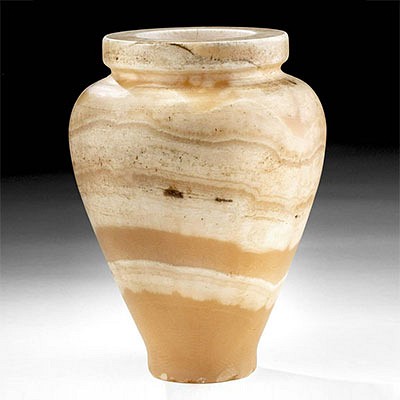Large Chinese Han Dynasty Pottery Horse w/ TL
Lot 82c
About Seller
Artemis Fine Arts
686 S Taylor Ave, Ste 106
Louisville, CO 80027
United States
Selling antiquities, ancient and ethnographic art online since 1993, Artemis Gallery specializes in Classical Antiquities (Egyptian, Greek, Roman, Near Eastern), Asian, Pre-Columbian, African / Tribal / Oceanographic art. Our extensive inventory includes pottery, stone, metal, wood, glass and textil...Read more
Categories
Estimate:
$4,000 - $6,000
Absentee vs Live bid
Two ways to bid:
- Leave a max absentee bid and the platform will bid on your behalf up to your maximum bid during the live auction.
- Bid live during the auction and your bids will be submitted real-time to the auctioneer.
Bid Increments
| Price | Bid Increment |
|---|---|
| $0 | $25 |
| $300 | $50 |
| $1,000 | $100 |
| $2,000 | $250 |
| $5,000 | $500 |
| $10,000 | $1,000 |
| $20,000 | $2,500 |
| $50,000 | $5,000 |
| $100,000 | $10,000 |
| $200,000 | $20,000 |
About Auction
By Artemis Fine Arts
Dec 17, 2020
Set Reminder
2020-12-17 10:00:00
2020-12-17 10:00:00
America/New_York
Bidsquare
Bidsquare : VARIETY SALE | Antiquities & Ethnographic Art
https://www.bidsquare.com/auctions/artemis-gallery/variety-sale-antiquities-ethnographic-art-6207
Featuring classical antiquities, ancient and ethnographic art from cultures encompassing the globe. Egyptian, Greek, Roman, Etruscan, Near Eastern, Asian, Pre-Columbian, Native American, African / Tribal, Oceanic, Spanish Colonial, Russian, Fossils, Fine Art, more! Artemis Fine Arts info@artemisgallery.com
Featuring classical antiquities, ancient and ethnographic art from cultures encompassing the globe. Egyptian, Greek, Roman, Etruscan, Near Eastern, Asian, Pre-Columbian, Native American, African / Tribal, Oceanic, Spanish Colonial, Russian, Fossils, Fine Art, more! Artemis Fine Arts info@artemisgallery.com
- Lot Description
East Asia, China, Han Dynasty, ca. 206 BCE to 220 CE. An incredible Han Dynasty statue of a horse, standing with his back left hoof lifted, presenting a lively visage with bulging eyes, raised ears, a pronounced snout with flared nostrils and an open mouth revealing his teeth and likely neighing - tail molded seprately. The horse is also presented with a neatly manicured mane and finely delineated white swirling patterns adorning his red coat. During the Han dynasty, the ancients placed such model figures in tombs to ensure a safe journey to the afterlife. Size: 19.8" L x 6.5" W x 24.375" H (50.3 cm x 16.5 cm x 61.9 cm)
During this period of Chinese history, horses came from the Ferghama Valley in Central Asia - present day Afghanistan. When elite individuals passed away, "walking" terracotta Ferghama horses displaying an immense degree of attention to detail, like this example, were created to carry the deceased into the hereafter. The horse, second only in importance to the dragon, was believed to possess magical powers. The number of horses owned by an individual ensured his high status in the afterlife.
Funerary sculptures like this piece are part of a class of artifacts called mingqi - sometimes known as "spirit utensils" or "vessels for ghosts". They became popular in the Han Dynasty and would persist for several centuries. Alongside figures like this one were musicians, athletes, animals, structures, and more. Even though they were mass produced, mingqi of the Han Dynasty often show a high level of detail and naturalism. These were designed to assist the po, the part of the soul of the deceased that remained underground with the body while the hun, the other part of the soul, ascended. According to scholars, caring for the po took on a new level of meaning in the Han period, with more elaborate rituals and tomb construction arising.
This piece has been tested using thermoluminescence (TL) analysis and has been found to be ancient and of the period stated. A full report will accompany purchase.
Provenance: ex-J. Meador Chicago, Illinois, USA acquired 2010s; ex-Pegasus Gallery Antiquities, Antiquities and Ancient Art; ex-private collection, Bristol UK acquired pre 1930; acquired by Peter Thomas, Huddlesfield, 1990 to 2019; acquired by Alexander Hardy, Bristol, 1907 to1990
All items legal to buy/sell under U.S. Statute covering cultural patrimony Code 2600, CHAPTER 14, and are guaranteed to be as described or your money back.
A Certificate of Authenticity will accompany all winning bids.
We ship worldwide and handle all shipping in-house for your convenience.
#155679Repaired from multiple pieces, with restoration to areas of all four legs, body, neck, head and tail, and resurfacing with overpainting along new material and break lines. Original tail and brow element missing as shown. Abrasions to legs, body, neck, and head, with softening to some finer details, fading and touch-up painting to original pigment and encrustations. TL drill holes beneath body near opening and beneath head.Condition
- Shipping Info
-
All shipping is handled in-house for your convenience. Your invoice from Artemis Gallery will include shipping calculation instructions. If in doubt, please inquire BEFORE bidding for estimated shipping costs for individual items.
-
- Buyer's Premium



 EUR
EUR CAD
CAD AUD
AUD GBP
GBP MXN
MXN HKD
HKD CNY
CNY MYR
MYR SEK
SEK SGD
SGD CHF
CHF THB
THB















